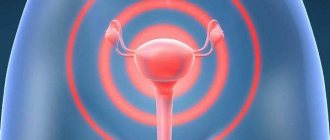The course of the next menstrual cycle directly depends on the processes of hormone synthesis, namely on the amount of progesterone and testosterone produced by the body. If no deviations in these processes are observed, menstruation should come on time and with the usual level of abundance of the discharge itself. Excessive synthesis of one of the hormones causes cycle failure. In this case, uncharacteristic pain in the lower abdomen and a feeling of heaviness may also be observed.
A more dangerous phenomenon is considered when there is a delay and a temperature that remains at 37 degrees. The reasons for this condition may be different, so a mandatory consultation with a gynecologist is required. A delay in menstruation with such a symptom is typical not only for the onset of pregnancy, but can signal the presence of more serious diseases that require timely and correct treatment.
If there is an increase in body temperature, deterioration in general condition and unusual painful sensations, you should consult a doctor and undergo an examination. This will allow us to determine in advance the true cause of the health problems of each woman in individual cases and prevent dangerous complications.
Main phases of the cycle
Many women know that ovulation occurs in phase 2 of the cycle, which approaches the onset of menstruation. Testosterone begins to be produced in excess, and optimal conditions for conception are created in the uterine cavity. About 8-10 days before the onset of menstruation, body temperature rises to 37 degrees, which is facilitated by the effect of progesterone on the brain. Then there is a decline in progesterone levels, a delay in menstruation and a temperature of 37 degrees.
It is acceptable to increase temperature values with the active production of progesterone, which provokes a delay in menstruation. It's all about the influence of this hormone on the thermoregulatory center of the brain of the head.
There are 3 phases in the menstrual cycle, in each of which there is an imbalance of hormones, jumps in one direction or another:
- Phase 1 – the arrival of menstruation, a decrease in hormone levels (progesterone, estrogen), rejection of the uterine mucosa layer.
- Phase 2 – an increase in the concentration of follicles and the hormone responsible for stimulating the maturation of the egg, when fertilization is possible. This increases the basal temperature. The uterus is preparing for possible fertilization. The appearance of a temperature of 37° during this period and delays in regulation may indicate the onset of pregnancy.
- Phase 3 – the end of the menstrual cycle, an increase in hormone levels, the arrival of menstruation in the next month.
The duration of the cycle directly depends on the individual characteristics of the woman. You can monitor stability yourself using the calendar method, or determine safe days in case of unprotected sex or the optimal time for conceiving a baby. But the absence of menstruation at the scheduled time and a negative test is a signal for women to worry, consult a doctor and identify possible disorders at an early stage.
Decryption nuances
A doctor should decipher and make diagnoses. A woman can only understand at an everyday level what is happening in her body. Here you should know not only the standards for basal temperature, but also all the nuances that may indicate pathologies.
- BT in the first and second phases should differ by at least 0.4 degrees. Before ovulation it is lower than after ovulation.
- All factors that influenced changes in BT indicators should be taken into account.
- If BT readings indicate pregnancy, a pregnancy test should be used. Also, one should not rush into pathological diagnoses. Their presence can be confirmed only after all tests have been completed.
- If there is a delay, this may indicate either pregnancy or gynecological problems.
You only need to worry if BT readings were taken over several months in a row. Deviations from the norm noted in the first days of measuring BT may indicate that the woman does not know the characteristics of her body or is taking readings incorrectly.
go to top
Reasons for rising temperature
Pregnancy can be assumed if your period does not arrive on time, although a delay in menstruation and a temperature of 37 are acceptable and the test shows a negative result. This happens in a number of cases when ovulation comes late. Provoking factors may be the following:
- inflammation of the ovaries, which contributes to an increase in temperature and delayed menstruation;
- the development of endometriosis, as a clear sign of delayed menstruation and increased temperature;
- overwork;
- stress;
- irregular sports activities;
- sudden change in climate, place of residence;
- starvation;
- psycho-emotional instability;
- disruption of the endocrine and nervous system;
- frozen ectopic pregnancy, when the basal temperature during a delay in menstruation is 37.1 degrees and a negative test, while the fertilized egg is located at the bottom of the uterus, the production of hCG is observed in small quantities.
Provoking factors can lead to hormonal imbalance and an increase in temperature in the late afternoon.
On a note! Women are recommended to measure their basal temperature immediately after waking up using a mercury thermometer. Temperature fluctuations are acceptable at different periods of the cycle and this is the norm. The temperature before ovulation should be below 37 degrees, before menstruation 2-3 days - above 37.2 degrees. If the temperature is elevated, the delay is 3-4 days, and the test is negative, then this is a signal for concern.
When T is above 38 degrees and a delay in menstruation, pathology may develop in the appendages and uterine cavity. It is necessary to contact specialists.
Delay 8 days, tests negative, temperature 37.5
Chronic diseases: Allergy to ragweed, gastritis, periodic headaches (low blood pressure).
Hello, my boyfriend and I had coitus interruptus several times in the middle of the cycle, and now the delay is already 8 days. I did three tests at intervals of 2 days, strictly according to the instructions, negative, one line and not a hint of a second. And I don’t feel any signs of pregnancy, even with digestion everything is normal (although I have problems with this on ordinary days), my breasts are unchanged. BUT one thing is alarming: in the evenings I have been measuring my body temperature for two days now - 37.5, headaches every day, slight pain in the lower back and a little in the legs, as with PMS. Another nuance - in February there was a sharp warming, almost 20 degrees - could this disrupt the cycle? Is it normal to have an elevated temperature during a delay? (I didn’t measure it before my period before). And could it suddenly be pregnancy if the act was interrupted? Pregnancy is VERY undesirable for now, and I'm worried. Thank you in advance.
Tags: delay temperature 37 test negative, delay and body temperature 37 test negative, temperature 37 delay test negative
Related and recommended questions
Temperature in the vagina Temperature in the vagina is higher than body temperature! Why?
Delay 9 days, temperature 37.1 Help me! I was 9 days late at this time.
Delay 7 days test negative I am 18 and have not had sexual intercourse with MCH for 3 months.
Delay 8 days, test negative. Please tell me. I am 8 days late (cycle.
Delay 11 days, test negative I am 11 days late. On the second day of the expected.
Delay test negative I have been delayed for a week now. Usually 5 days before your period.
Delay 6 days test negative I am delayed for the 6th day. 2 tests are negative.
Don't forget to rate doctors' answers and help us improve them by asking additional questions about the topic of this question.
Also, don’t forget to thank your doctors.
Hello! Coitus interruptus is the most unreliable method of contraception - only 60-65% guarantee. This is for the future. Of course, 3 tests cannot be wrong, but in order to finally remove the question of pregnancy, you need to take a blood test for hCG, the pregnancy hormone. Everything else is not symptoms for the intended condition. Perhaps there is a slight cystitis and it is worth taking a urine test. Perhaps a hormonal imbalance due to weather conditions and stress. If the delay is more than 14 days, you need to do an ultrasound of the pelvic organs and seek an in-person consultation. Health to you!
Irina
2015-04-10 09:20
Hello, I always have unprotected sex with my husband, but now I’m 6 days late and the test is negative. The signs I have are the following: a tightening of the lower back, an aversion to food, but sometimes I want to eat so badly, in the morning I felt slightly nauseous, but not now. Headaches, frequent urination and all the current agitation, strong heartbeat, basal temperature of 37.4 stays that way
Hello! Irina, first of all, you didn’t ask the question. Secondly, punctuation (punctuation marks) is not superfluous in speech and helps to understand you
Natalia
2015-11-30 08:57
Good afternoon, I have such a problem today, 5 days of delay with my husband, we are planning a pregnancy. Last menstruation was on October 30, ovulation was ovulation was on November 11, PA was on November 8 and 9, not protected! BT is 36.9-37 in the morning! Tell me, can I be pregnant? The test shows 1 line! I took different companies
Hello! Donate blood for hCG - within 7-10-14 days from the date of potential conception, this test will answer your question about pregnancy. Health to you!
Evgeniya
2016-02-05 18:57
Hello, I’m 20 years old, I use interrupted sex protection, my last sexual intercourse was 2.5 weeks ago, my monthly cycle is not stable, but here’s the problem: 17 days after my period, scanty bleeding began, sometimes even brown, and it hasn’t stopped for almost 3 weeks, I did 2 tests, just in case, at intervals of 3 days - both were negative. In this case, the elevated temperature varies from 37-2 to 37-5, and the pressure decreases. During this period, an illness (common cold) was transmitted. So, please tell me what it could be?
Pregnancy
With the onset of pregnancy, hormonal levels change radically. There is an increase in basal body temperature and the manifestation of other unpleasant symptoms. The test may show a negative result if there is a delay of 2-3 days. To be sure of the onset (absence) of pregnancy, women are recommended to undergo hCG and a blood test.
Symptoms during pregnancy may include the following:
- swelling of the mammary glands and pain on palpation;
- delayed menstruation and basal temperature of 37.3 degrees against the background of increased production of progesterone;
- excessive fatigue;
- decreased blood pressure;
- early toxicosis;
- vomiting, nausea;
- loose stool.
If the test is negative, then the reason may be a defective device. To eliminate various conjectures, a woman is recommended to consult a gynecologist and undergo an examination to confirm an accurate diagnosis. After 3.5 weeks from the date of missed period, the doctor will be able to accurately determine the cause and prescribe treatment as necessary.
Possible pathologies
Delayed menstruation, temperature 37, negative test - such symptoms may indicate a developing disease. In this case, you should immediately contact a medical facility. The specialist will conduct a thorough examination, based on the results of which he will make an accurate diagnosis and, if necessary, prescribe appropriate treatment.
Symptoms such as delay, temperature 37, negative test may be a manifestation of the following conditions:
Polycystic ovary syndrome is accompanied by characteristic symptoms - excessive hair growth on the face, legs, groin area, increased oiliness of hair and skin, acne.
Today, this disorder is successfully treated with contraceptives. The right drug will help normalize hormone levels. If left untreated, this pathology can lead to infertility.
Physiological reasons
When the temperature rises to 37 degrees, there is a delay in menstruation, then the reasons of a physiological nature may be:
- anorexia;
- mental disorder;
- bulimia;
- sudden climate change;
- lifting weights;
- stress.
A temperature of 37 and a delay in menstruation are only normal:
- In girls during the period of restoration of the menstrual cycle, when menstruation is still irregular and a delay should not be a cause for concern.
- In older women during menopause, as reproductive functions decline. A temperature of 37.2 degrees and above is also considered normal. The menstrual cycle becomes irregular, because the hormonal balance is rebuilt. Even in the complete absence of menstruation, there is no need to panic.
Menstrual days may be delayed due to acute respiratory infections, ARVI, but in order to avoid health problems in the future, women need to listen to their body. The slightest deviations and unpleasant symptoms should be the reason for a comprehensive examination.
Infectious and inflammatory diseases
Critical days may be delayed due to colds and viral infections. Women need to learn to listen to their bodies. If additional unpleasant symptoms occur, it is necessary to undergo a comprehensive examination.
When, during a delay in menstruation, the temperature rises above 37.5 o C, this indicates the presence of pathology and is not the norm. It is necessary to consider in more detail the conditions when there is a high temperature simultaneously with a delay in menstruation.
Salpingitis
Infectious and inflammatory disease of the fallopian tubes. The disease is caused by streptococci, staphylococci, E. coli, fungi of the genus Candida, and mixed flora. For nonspecific salpingitis, unilateral damage to the tube on the right or left is more typical.
The specific nature of salpingitis is caused by chlamydia, gonococci, trichomonas, and mycobacterium tuberculosis. As a rule, specific forms affect pipes on both sides.
- a sharp deterioration in health;
- chills, fever;
- pain in the lower abdomen;
- irradiation of pain to the rectum, sacrum;
- purulent discharge;
- symptoms of intoxication.
The etiology is often associated with surgical termination of pregnancy, difficult childbirth, and gynecological manipulations. Treatment with antimicrobial drugs is prescribed based on the results of bacteriological culture.
The inflammatory process affects the ovaries. The disease is characterized by aching, dull pain in the abdomen and groin area, and mucopurulent discharge. At the same time, the menstrual cycle is disrupted and the temperature rises.
Pathological causes
It happens that a body temperature of 37 and a delay in menstruation are observed for pathological reasons, when the consequences can be serious and one can no longer hesitate to contact a specialist:
- inflammatory course in the uterus, dilatation of the cervix before the arrival of critical days in case of infection;
- endometritis with inflammation of the endometrial mucosa, additionally observed: high body temperature up to 39 degrees, dull pain in the lower abdomen, increased heartbeat, painful urination;
- salpingoophoritis, inflammation of the uterine appendages;
- premenstrual stress or syndrome that provokes a rise in temperature to 38°;
- inflammation of the ovaries with possible involvement of the appendages, symptoms: fever up to 40°, delayed menstruation, vomiting, malaise, excessive sweating, pain, burning and cramping when urinating.
Such signs cause severe discomfort. We can talk about pathology against the background of delayed menstruation, elevated temperature up to 37.4 degrees and above. This is no longer the norm. In order to identify foci of the disease at the initial stage, women should quickly contact doctors in order to eradicate such manifestations.
Relationship between temperature and delay
Starting approximately from the middle of the cycle, from the moment of ovulation, the female genital organs produce progesterone; comfortable conditions and optimal temperature are needed for successful conception. Progesterone stimulates the thermoregulation center of the brain, increases body temperature to subfebrile levels (37.0-37.5).
From the moment menstruation begins, the amount of progesterone decreases, and along with it, temperature indicators drop. If there is a delay, the temperature may be slightly elevated, as progesterone is actively produced and continues to affect the thermoregulation center.
An increase in temperature and a delay in the monthly cycle are related to each other and more often indicate pathology and problems. But for some women, an increase to 37 with a delay is a normal condition. This feature is observed in 25% of women.
When the temperature is 37 or a little more together with a delay, this may indicate pregnancy. After successful fertilization, an increase in body temperature is considered normal . The excess may persist for several days, sometimes up to one month.
What is basal temperature?
The basal temperature when menstruation is delayed is 37 degrees. It is considered normal during the ovulation period and allows women to determine the degree of normal functioning of the menstrual cycle. The results will be informative only if you constantly measure your basal temperature (especially if your period is delayed) for 3 cycles in a row.
Basal temperature allows:
- plan the gender of the child;
- monitor the proper functioning of body systems;
- establish infertility at an early stage;
- increase the chances of quick conception;
- identify hormonal imbalances in a timely manner.
The indicators must be written down in a notebook every day, what is the basal temperature in the morning or evening, thus creating a schedule to get a clearer picture of tracking the processes occurring in the reproductive system. Temperature readings may vary slightly depending on the phase of the menstrual cycle. The following are considered normal:
- 1st phase 36.2-36.6 degrees due to the predominance of estrogen;
- Phase 2 or preovulation period, temperature 36 degrees;
- Phase 3, second half of the cycle – temperature rises to 37.5 degrees as the follicle ruptures.
IMPORTANT! If the test is negative and the temperature is 37.1 degrees on the expected day of ovulation, there is a high probability of an ectopic pregnancy, the absence of embryo development as the endometrium penetrates into the uterus. It is worth contacting a gynecologist.
If 2-3 days before the expected arrival of menstruation, the production of hCG does not occur and the temperature readings are elevated, then this indicates successful fertilization. The test may initially show a negative result. Then the basal temperature should decline, which also confirms the fact of pregnancy.
Attention! The threat of miscarriage is preceded by similar signs and results of hCG. If unpleasant symptoms appear, a woman should urgently consult a gynecologist for advice and undergo an examination.
Measurement Rules
To obtain correct BT measurements, you must follow all the rules that allow you to catch the moment when the temperature is the lowest:
- Measurements should be taken only after a night's sleep, which should last at least 5-6 hours continuously.
- Measurements should be taken in three suggested places: in the vagina, in the rectum (which gives the most accurate measurements) or in the mouth. Hold the thermometer in your mouth under your tongue for 5 minutes. In other methods, you can hold the thermometer for 3 minutes.
- Measurements should be taken immediately after sleep at the same time. The difference can be 30 minutes in time.
- Measurements are taken only in the same way (oral, vaginal or rectal). In this case, one thermometer is used. It is better to choose a mercury thermometer to measure BT.
- The thermometer should be prepared in the evening for measurement by knocking it down. It should be placed near the bed so that in the morning, without getting out of bed, you can reach it and immediately begin measuring.
- It is forbidden to get out of bed, stretch, or perform active actions. It is better to measure BT as soon as the woman wakes up.
- You should know that the basal temperature begins to rise as soon as a person begins to make efforts and move. Every hour it rises by 0.1 degrees, which already gives unreliable data. Therefore, measurements are taken not during the day or in the evening, but only in the morning.
- If sleep turns out to be intermittent, then temperature measurements should be taken only after 3-4 hours of sleep. Get up, do what you have planned and then go to bed. Otherwise the measurements will be distorted.
- The readings are taken in the supine position, which is natural if the woman does not get out of bed.
- After removing the thermometer, we immediately find out the temperature and enter it into the chart.
- The thermometer readings are between two numbers - fix the lower number.
- If a woman works at night, then measurements are taken after daytime sleep.
- All factors that could influence its change should be noted in the BT chart. These include:
- Sex the day before.
- Long journey the previous day.
- An increase in the overall body temperature, which affects the basal temperature.
- Taking sleeping pills, sedatives, oral contraceptives or hormonal drugs.
- Drinking alcohol the night before.
- It is better to measure the temperature before 8 am.
- Measurements are taken daily, even during menstruation. The schedule is maintained for at least 3-4 months in a row.
You can suspect pregnancy only if the BT chart shows that ovulation has occurred. After all, during the year there are 2 periods when ovulation does not occur, which is normal.
go to top
When should you worry?
In the best case, a delay in menstruation and a temperature of 37° is a fact of pregnancy. But this is provided that the woman has regular sex life. But what to do if your period doesn’t come, there’s only 1 line on the test? The reason may be hidden in hormonal imbalance, inflammation of the ovary or polycystic syndrome.
In the first time after childbirth during breastfeeding, women experience a fairly long menstrual cycle, but this is a normal phenomenon due to changes in the body. There is a temporary absence of internal instincts for the arrival of ovulation and the sending of signals to the brain for the onset of ovulation. This is not a cause for concern; a woman needs to wait until new periods form.
If the basal temperature is 37 degrees, the test is negative, then in case of doubt, of course, it is better for the woman to see a gynecologist. The reasons for this condition may be different:
- severe inflammatory processes;
- internal diseases that can lead to damage to the uterus and other genital organs.
It is necessary to conduct a full examination, identify deviations, and eliminate provoking causes. Women are recommended:
- keep a diary, record the dates of the onset (end) of menstruation, the duration of the ovulation period, the amount of discharge, any side symptoms;
- be examined by a gynecologist 2 times a year.
It happens that the primary signs of pathology on the first day of the delay and up to 3-4 subsequent days do not make themselves felt, but as the disease develops they begin to negatively affect the hormonal background. The reasons may be different: stress, physical strain. The menstrual cycle and reproductive functions in women are completely controlled by certain hormones, which trigger many mechanisms in the body.
When to worry
The safest reason for observing a delay in menstruation and elevated body temperature is pregnancy. In other cases, it is extremely important to determine the cause in advance and undergo full treatment of the detected diseases.
You should be concerned, first of all, if your basal temperature is elevated (at 37 degrees), as well as if other dangerous symptoms appear and a general deterioration of your condition. This includes vomiting, dizziness, itching and burning in the genital area (especially during urination), low blood pressure, as well as severe cutting pain in the lower abdomen.
As a rule, the listed symptoms signal not only severe forms of inflammatory processes, but also other types of diseases that provoke damage to the uterus and other organs of the reproductive system of the female body. As a preventive measure, it is recommended to undergo examination by a gynecologist every six months. At the same time, it is important to keep a diary with timely entries about the beginning and cessation of menstruation, the level of profuse bleeding, and the duration of ovulation. In such records, uncharacteristic or side effects are also necessarily noted, for example, the manifestation of cutting pains and their total duration.










